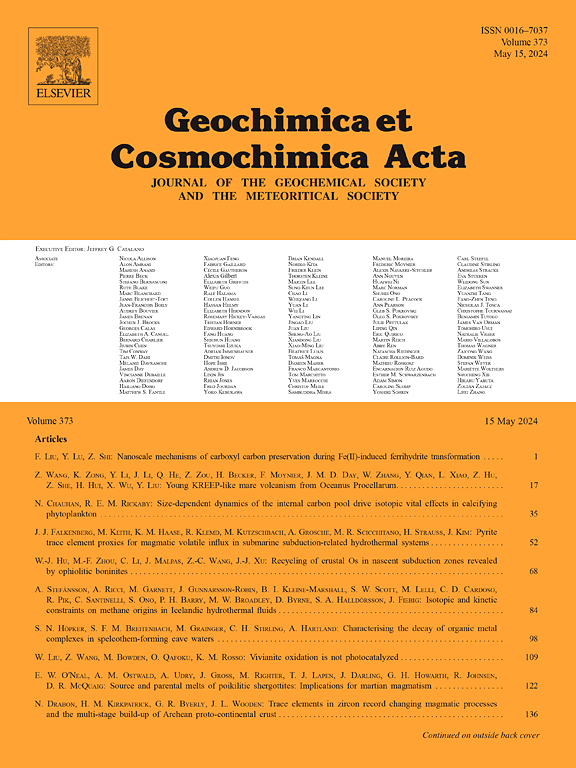Gold(I)-bisulfite complexation in hydrothermal nanodroplets: A molecular dynamics study
IF 5
1区 地球科学
Q1 GEOCHEMISTRY & GEOPHYSICS
引用次数: 0
Abstract
Water nanodroplets present a unique environment for gold hydrothermal transport, with fluid properties in aqueous nanodroplets distinct from bulk liquid and vapor phases. By performing classical and ab initio molecular dynamics simulations, we have probed the stability of water nanodroplets (H2O)n (n = 100, 1000) at 25 °C and 100 °C. The solvation and complexation of gold(I)-bisulfite AuHSO3 in nanodroplet environments were also examined, with a particular focus on surface and interior solvation. Classical TIP4P/2005 molecular dynamics simulations reveal extreme densities in the interior of (H2O)100 and (H2O)1000 nanodroplets compared to droplet surface regions. At 25 °C, the interior region of (H2O)100 exhibits fluctuating densities at 1.016–1.079 g/cm3, with two maxima at 1.079 g/cm3 and 1.074 g/cm3, corresponding to pressures of ∼ 2.23 kbar and 2.07 kbar, respectively; Reduced densities are predicted for the larger (H2O)1000 systems, these being 1.013 g/cm3 (25 °C, 370 bar) and 0.968 g/cm3 (100 °C, 220 bar). The outer regions, on the other hand, featured densities intermediate between saturated liquid and vapor conditions, as part of a transition from liquid to vapor-like densities at the edge of the droplet. Born-Oppenheimer molecular dynamics simulations at 100 °C show that the gold(I)-bisulfite complex H2O-AuHSO3 maintains a near linear solvation structure (θO-Au-S = 172°-174°) in bulk aqueous fluids and at surface and interior sites of (H2O)100 nanodroplets. Distance constrained simulations reveal that, upon extension of the gold(I)-bisulfite Au-S contact (equilibrium rAu-S = 2.3 Å), HSO3− is displaced by a water molecule, forming a two-water solvation shell around Au+. Thermodynamic integration gives gold(I)-bisulfite dissociation energies (ΔG) of 17.65 ± 0.37 kcal/mol (bulk), 20.22 ± 0.38 kcal/mol (nanodroplet surface), and 18.31 ± 0.31 kcal/mol (nanodroplet interior). Our ab initio molecular dynamics results demonstrate that water nanodroplets are stable at hydrothermal conditions and would play an important role in the speciation and transport of gold in volcanic and hydrothermal vapors.
水热纳米液滴中金(I)-亚硫酸氢盐络合:分子动力学研究
纳米水滴具有不同于整体液相和气相的流体性质,为金的热液输运提供了独特的环境。通过经典分子动力学和从头算分子动力学模拟,研究了纳米水滴(H2O)n (n = 100,1000)在25°C和100°C下的稳定性。研究了纳米液滴环境下金(I)-亚硫酸氢盐AuHSO3的溶剂化和络合作用,重点研究了表面和内部的溶剂化。经典的TIP4P/2005分子动力学模拟显示,与液滴表面区域相比,(H2O)100和(H2O)1000纳米液滴内部的密度极高。在25°C时,(H2O)100的内部区域呈现出1.016-1.079 g/cm3的波动密度,有两个最大值分别为1.079 g/cm3和1.074 g/cm3,对应的压力分别为~ 2.23 kbar和2.07 kbar;对于较大的(H2O)1000体系,预计密度会降低,分别为1.013 g/cm3(25°C, 370 bar)和0.968 g/cm3(100°C, 220 bar)。另一方面,外部区域的密度介于饱和液体和蒸汽条件之间,作为液滴边缘从液体到蒸汽密度过渡的一部分。Born-Oppenheimer在100℃下的分子动力学模拟表明,金(I)-亚硫酸氢盐配合物H2O- auhso3在大量水溶液中以及(H2O)100纳米液滴的表面和内部位置保持近线性溶剂化结构(θO-Au-S = 172°-174°)。距离约束模拟表明,随着金(I)-亚硫酸氢盐Au- s接触的扩展(平衡rAu-S = 2.3 Å), HSO3 -被水分子置换,在Au+周围形成双水溶剂化壳层。热力学积分得到金(I)-亚硫酸氢盐解离能(ΔG)分别为17.65±0.37 kcal/mol(体积)、20.22±0.38 kcal/mol(纳米液滴表面)和18.31±0.31 kcal/mol(纳米液滴内部)。我们的从头算分子动力学结果表明,水纳米滴在热液条件下是稳定的,并将在火山和热液蒸汽中金的形态和运输中发挥重要作用。
本文章由计算机程序翻译,如有差异,请以英文原文为准。
求助全文
约1分钟内获得全文
求助全文
来源期刊

Geochimica et Cosmochimica Acta
地学-地球化学与地球物理
CiteScore
9.60
自引率
14.00%
发文量
437
审稿时长
6 months
期刊介绍:
Geochimica et Cosmochimica Acta publishes research papers in a wide range of subjects in terrestrial geochemistry, meteoritics, and planetary geochemistry. The scope of the journal includes:
1). Physical chemistry of gases, aqueous solutions, glasses, and crystalline solids
2). Igneous and metamorphic petrology
3). Chemical processes in the atmosphere, hydrosphere, biosphere, and lithosphere of the Earth
4). Organic geochemistry
5). Isotope geochemistry
6). Meteoritics and meteorite impacts
7). Lunar science; and
8). Planetary geochemistry.
 求助内容:
求助内容: 应助结果提醒方式:
应助结果提醒方式:


